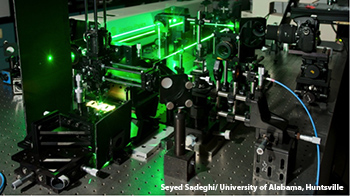
Experimental set-up used to analyze the behavior of quantum dots placed on metal oxides.
For such tiny structures, quantum dots already produce plenty of light. Researchers at two U.S. universities have been exploring environmental tweaks that make the emission from some of these nanocrystals more resistant to decay.
Working with commercially available colloidal quantum dots, scientists at the University of Alabama in Huntsville and the University of Oklahoma found that placing the quantum dots on ultrathin metal oxide layers increased their light emission (J. Appl. Phys., doi: 10.1063/1.4894445). Dots without protective shells glowed even more brightly on the substrate than dots with these coatings.
The team led by Alabama physicist Seyed Sadeghi previously studied one type of quantum dot and its interaction with aluminum oxide and chromium oxide. For the new experiments, the researchers used four types of cadmium selenide nanocrystals, three of which had zinc sulfide outer shells. Two of the dot types contained sulfur along with cadmium and selenium in their cores.
The scientists spread the dots onto aluminum oxide and chromium oxide films about 1 nm thick, supported by borosilicate glass substrates, and irradiated them with laser light of low and high intensities. The nanocrystals glowed more brightly on the aluminum oxide film, with the effect more pronounced for dots without protective shells.
In addition, the researchers looked at the photo-oxidation of the quantum dots when they are exposed to atmospheric oxygen. Such light-induced oxidation shrinks the dots, resulting in less light emission. The particles with the tertiary (cadmium, selenium and sulfur) cores glowed more brightly in the presence of aluminum oxide despite their smaller sizes. The scientists are now working to develop an understanding of these effects.
